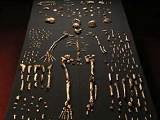New human species discovered in South Africa

A staggering trove of bones will shake up notions of how humans came to be.
THE Rising Star cave system in South Africa has yielded what is likely to be confirmed as the largest single find of hominin bones ever. A troupe of scientists slim enough to crawl into the system’s Dinaledi Chamber unearthed more than 1,500 bones in 2013 and 2014. This week, they were revealed as belonging to an entirely new species: Homo naledi.
The find is an incredible boon for palaeoanthropologists, who often must identify species from a few scattered bone fragments. The H. naledi remains (pictured) belong to at least 15 individuals of varying ages, permitting invaluable insights on growth and development. And the collection, described in a pair of papers in eLife and in National Geographic, represents just what was easily obtained from the chamber’s floor; there are many more bones embedded in its walls.
Yet H. naledi presents far more questions than answers. It is a bewildering blend of features: a skull and tiny brain like that of Homo erectus, an upper body suited to climbing, like that of Australopithecus afarensis, and small teeth like those of far more modern hominins. There is evidence of a powerful thumb and a complex wrist that are distinctly human-like—clear signs of regular tool use. But the fingers are strongly curved, suggesting hands that were also regularly used for climbing. The specimens’ femurs have ridges never seen in a hominin. The list goes on.
Given the current taxonomy, then, it is impossible to know where H. naledi fits in. Knowing the age of the specimens would help, but their isolation in the chamber has so far frustrated the typical methods of using sediments or nearby animals to date them. (One tantalising possibility is that they survived until relatively recently, segregated from other hominins.)
In any case, the grab-bag of characteristics presented by H. naledi — and also by Australopithecus sediba, a species unearthed in South Africa in 2008 which presented a similarly confounding mix-and-match morphology — underscores a shift in palaeoanthropological wisdom. Evolution’s little experiments yield a many-branched tree and not just a timeline; physical features arise and disappear or persist in a way that frustrates efforts to define ancestry just on the basis of what old bones look like. As a result, the idea that there is one clear lineage from the australopithecines to humans via some small number of progressively more human-like ancestors must now be thrown out. And the more excavations are carried out far from eastern Africa, where most of the fossils underpinning our current understanding of the human family tree were dug up, the more diverse and interesting the human story will become.
Source: The Economist
